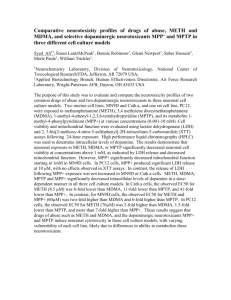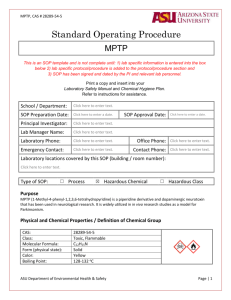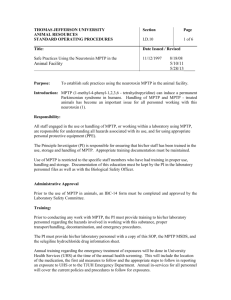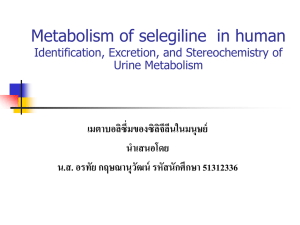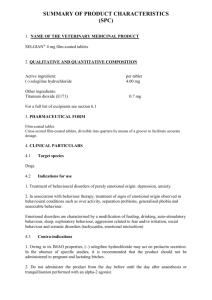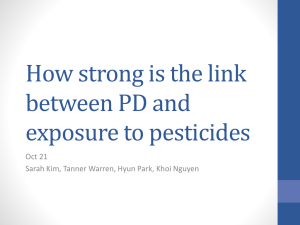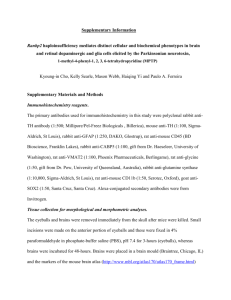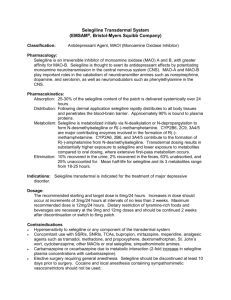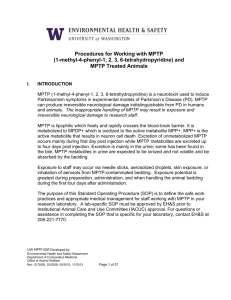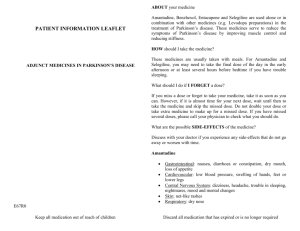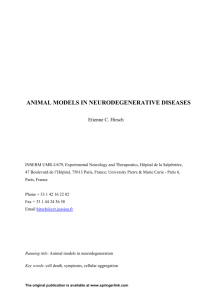MPTP - UCSF Occupational Health Program
advertisement
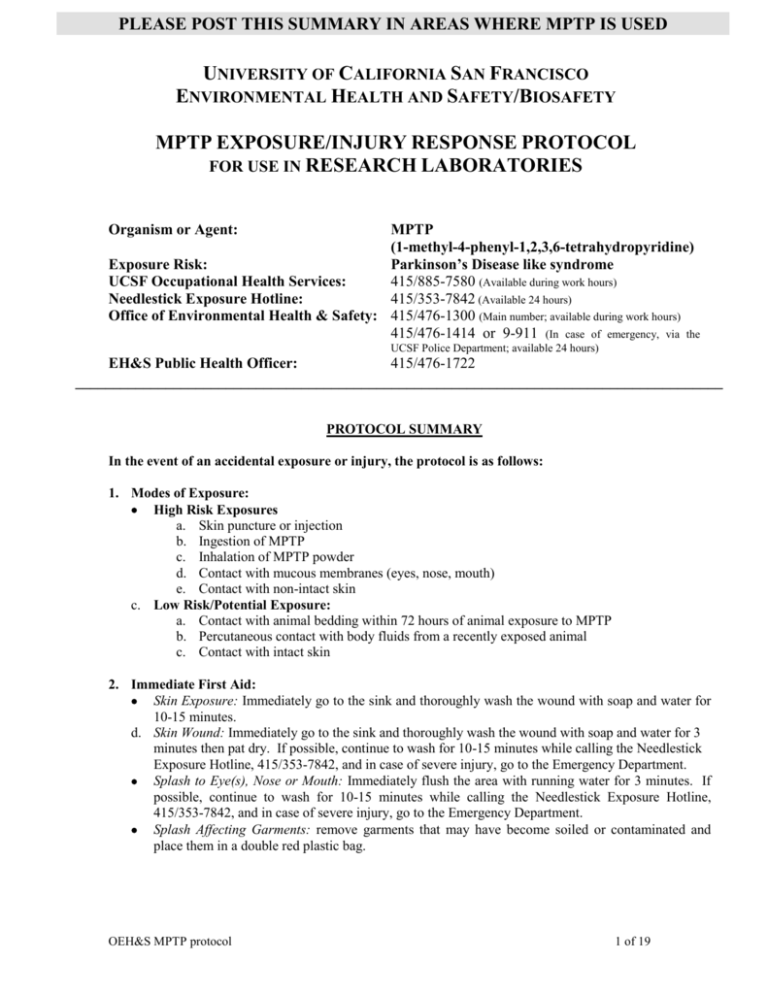
PLEASE POST THIS SUMMARY IN AREAS WHERE MPTP IS USED UNIVERSITY OF CALIFORNIA SAN FRANCISCO ENVIRONMENTAL HEALTH AND SAFETY/BIOSAFETY MPTP EXPOSURE/INJURY RESPONSE PROTOCOL FOR USE IN RESEARCH LABORATORIES Organism or Agent: MPTP (1-methyl-4-phenyl-1,2,3,6-tetrahydropyridine) Exposure Risk: Parkinson’s Disease like syndrome UCSF Occupational Health Services: 415/885-7580 (Available during work hours) Needlestick Exposure Hotline: 415/353-7842 (Available 24 hours) Office of Environmental Health & Safety: 415/476-1300 (Main number; available during work hours) 415/476-1414 or 9-911 (In case of emergency, via the UCSF Police Department; available 24 hours) EH&S Public Health Officer: 415/476-1722 ______________________________________________________________________________________ PROTOCOL SUMMARY In the event of an accidental exposure or injury, the protocol is as follows: 1. Modes of Exposure: High Risk Exposures a. Skin puncture or injection b. Ingestion of MPTP c. Inhalation of MPTP powder d. Contact with mucous membranes (eyes, nose, mouth) e. Contact with non-intact skin c. Low Risk/Potential Exposure: a. Contact with animal bedding within 72 hours of animal exposure to MPTP b. Percutaneous contact with body fluids from a recently exposed animal c. Contact with intact skin 2. Immediate First Aid: Skin Exposure: Immediately go to the sink and thoroughly wash the wound with soap and water for 10-15 minutes. d. Skin Wound: Immediately go to the sink and thoroughly wash the wound with soap and water for 3 minutes then pat dry. If possible, continue to wash for 10-15 minutes while calling the Needlestick Exposure Hotline, 415/353-7842, and in case of severe injury, go to the Emergency Department. Splash to Eye(s), Nose or Mouth: Immediately flush the area with running water for 3 minutes. If possible, continue to wash for 10-15 minutes while calling the Needlestick Exposure Hotline, 415/353-7842, and in case of severe injury, go to the Emergency Department. Splash Affecting Garments: remove garments that may have become soiled or contaminated and place them in a double red plastic bag. OEH&S MPTP protocol 1 of 19 3. Treatment: In the event of an acute injury resulting from a laboratory incident which requires immediate medical care, the injured employee should call 9-911 or report to the emergency department for acute medical treatment. The injured individual must take a copy of the complete “MPTP EXPOSURE/INJURY RESPONSE PROTOCOL” to the emergency department. The employee exposed to MPTP will need to be treated with selegiline. Call the Needlestick Exposure Hotline, 415/353-7842 to discuss the correct dosage. The exposure hotline responder will assess possible drug interactions and contraindications to selegiline. After taking selegiline, continue decontamination for a total of 10-15 minutes. If instructed by the exposure hotline, the exposed individual should go to an Emergency Department (ED). ***The patient should bring a copy of the complete MPTP post-exposure prophylaxis protocol to the ED and any follow-up appointment*** 4. The exposed employee is responsible for the following immediate steps after calling the Needlestick Exposure Hotline,: a. After first aid has been administered, immediately inform your supervisor of the exposure. b. In the event of a large spill, contact the emergency response team (9-911) for clean-up. c. Contact UCSF Occupational Health Services after first aid is complete, for follow-up care. OEH&S MPTP protocol 2 of 19 UNIVERSITY OF CALIFORNIA SAN FRANCISCO ENVIRONMENTAL HEALTH AND SAFETY/BIOSAFETY ROLES & RESPONSIBILITIES AFTER ACCIDENTAL EXPOSURE TO MPTP WORKER’S RESPONSIBILITIES (Employee/Student Initial Self-Care) First Aid: Perform the recommended first aid and decontamination according to the posted instructions. Treatment: i) In the event of an acute injury resulting from a laboratory incident which requires immediate medical care, the injured individual should report to the Emergency Department for acute medical treatment. ii) In the event of a MPTP exposure, call the Needlestick Exposure Hotline, 415 / 353-7842. Immediate post exposure prophylaxis is recommended provided there are no known medical contraindications to the treatment. Reporting: Inform your laboratory supervisor / principal investigator of the exposure. Secure the laboratory: Identify the equipment involved in the exposure and the mechanism of exposure. Make sure that the laboratory area has been secured and that notification of contamination has been posted to prevent other individuals from entering the area. Follow-up: Contact Occupational Health Services (OHS) as soon as possible for an appointment for follow-up care, if needed. SUPERVISOR’S RESPONSIBILITIES a. First Aid and Decontamination: Verify that the worker has washed and decontaminated himself/herself. Ensure that appropriate medical treatment has been received. b. Secure the laboratory: Confirm that the laboratory area has been secured and that notification of contamination has been posted to prevent other individuals from entering the area. c. Laboratory clean-up (as needed): Contact the Office of Environmental Health & Safety (OEH&S) through the UC Police Department Emergency Dispatch (from a campus telephone 9-911, from a noncampus phone 415/476-1414). d. Report the exposure: Call OHS at 415/885-7580 during regular hours. Briefly describe the circumstances of exposure. Provide employee/student identification information (name and home telephone number). e. Follow-Up: Confirm that the worker has called for an appointment at the UCSF Occupational Health Services for evaluation on the next weekday the clinic is open. Later, confirm that the worker has been evaluated and coordinate a safe return to work. f. Report the Injury: Within 24 hours, report the injury to the UCSF Human Resources Disability Management Services (HR DMS) Office on the Supervisor’s Report of Injury (SRI) form, available from: http://ucsfhr.ucsf.edu/dismgmt/forms/workcomp/claim/SRI.pdf PRINCIPAL INVESTIGATOR’S RESPONSIBILILTIES: It is the responsibility of the PI to ensure that the UCSF Biosafety Officer has been notified. A report summarizing any suspected MPTP exposure needs to be addressed to the Biosafety Officer and the IBC by the PI. The report must include the following: a. A description of the exposure event, a description of the area involved, and the extent of employee OEH&S MPTP protocol 3 of 19 exposure b. Specification of the amount of MPTP material released, with an explanation of procedures used to determine the amount involved c. Report of whether medical treatment was provided d. Corrective action taken to prevent the re-occurrence of the incident e. MPTP decontamination procedures Additional PI Responsibilities It is the responsibility of the PI and Laboratory Manager to ensure that all potentially exposed employees/workers have initial and annual training. a. Training should be conducted on an annual basis. Ensure that all workers with potential exposure to MPTP have been trained regarding the hazards of MPTP/selegiline and that all workers are thoroughly familiar with the post-exposure prophylaxis protocol. Do not allow anyone to perform work in which there is a potential for contamination with MPTP unless they have been trained. Access to the laboratory must be restricted to trained personnel when work is being conducted with MPTP. b. Documentation regarding initial and annual training should be maintained by the PI or lab manager. c. It is the responsibility of the PI and Laboratory Manager to ensure that procedures involving the use of MPTP are ideally only performed on a Monday or a Tuesday. This approach avoids the possibility of accidental exposure to animal bedding over a weekend. c. It is the responsibility of the PI and Laboratory Manager to maintain a supply of selegiline in each lab where MPTP work is performed. The selegiline must be stored in a readily accessible, but secure fashion. Check the bottle on a monthly basis to make sure it is not outdated. Make sure each lab has a complete copy of this MPTP post-exposure prophylaxis protocol posted and has a list of names of potentially exposed workers. d. Make certain that no one works alone when doing procedures that may result in MPTP exposure. There must be at least two people present. The second person must observe that procedure being performed to assist in the identification of any exposure. e. Secondary containment must be used when transporting MPTP to and from the biosafety cabinet. OEH&S MPTP protocol 4 of 19 UNIVERSITY OF CALIFORNIA SAN FRANCISCO ENVIRONMENTAL HEALTH AND SAFETY TOXIC SUBSTANCE DATA SHEET MPTP FOR USE IN RESEARCH LABORATORIES A. MATERIAL SAFETY DATA SHEET - CHEMICAL SUBSTANCES 1. SECTION I – TOXIC AGENT NAME: 1-methyl-4-phenyl-1,2,3,6-tetrahydropyridine SYNONYM OR CROSS REFERENCE: MPTP/2’-Amino-MPTP/2’-Methyl MPTP HCL CHARACTERISTICS: A synthetic meperidine analog with potent heroin-like effects. Exposure causes neurodegenerative changes similar to Parkinson’s disease. All precautions shall be taken to avoid human exposure. Low level exposure over time may result in cumulative permanent neurologic damage. 2. SECTION II - RECOMMENDED PRECAUTIONS EXPOSURE CONTROLS, PERSONAL PROTECTION Engineering Controls: Only handle in a chemical fume hood, if possible. Safety shower and eye wash available. Eye/Face Protection: MPTP. Chemical safety goggles. Full face respirator preferred when handling concentrated Hand Protection: Nitrile under latex gloves. Respiratory Protection: Where risk assessment shows air-purifying respirators use a full face particle respirator type N99 as a backup to engineering controls. Administrative: There is always a second member of staff who observes the procedure during the use of MPTP. CONTAINMENT REQUIREMENTS: Minimum Biosafety level 2 with materials known or potentially containing the toxin; Biosafety level 3 for activities with a high potential for aerosols. RESEARCH ANIMAL CONTAMINATION AND RISKS: At about 2 days post-injection, 70% of the total injected dose of MPTP and metabolites has been excreted. The main route of excretion is through urine. Animal bedding and excreta of treated animals should be considered high risk for 5 days after treatment.¹ PROTECTIVE CLOTHING: Laboratory coat; gloves and gown (tight wrist and tie in back) when handling toxin. A one piece Tyvek garment with attached hood, elasticized wrists and attached boots is preferred. A full face respirator is the preferred respiratory protection, although a half face respirator can be used. After each use, the respirator should be thoroughly wiped with 1% bleach solution and then washed with detergent. OTHER PRECAUTIONS: Any contact should be avoided OEH&S MPTP protocol 5 of 19 3. SECTION III - HANDLING INFORMATION SPILLS: Use 1% solutions of sodium hypochlorite (Commercial bleach usually comes as a 5% stock solution, i.e. use a 1:4 dilution of Clorox). Contact time recommended: 10 minutes. DISPOSAL: Dispose of all contaminated materials as hazardous chemical waste. STORAGE: In sealed containers that are appropriately labeled 4. SECTION IV - HEALTH HAZARD PATHOGENICITY: Originally associated with an outbreak of a neurodegenerative disease in young injectable drug users, the chemical is now used in research to create a model of Parkinson’s disease in experimental animals. The chemical undergoes complex multistep metabolism, leading to formation of MPP+, the toxin that destroys neurons. Following injection, MPTP levels can be detected in the brain within 1 minute. Pretreatment of animals with MAO-B inhibitor before administration of MPTP prevents neurological damage to dopaminergic neurons. PROBABLE HUMAN TOXIC THRESHOLD: Percutaneous Exposure: 0.001mg/kg. GI/Mucosal exposure: 0.1mg/kg. MODE OF EXPOSURE: Skin Puncture/injection/ingestion/inhalation/contact with mucous membranes/contact with non-intact skin. Potential exposure from contact with animal bedding especially within 72 hours of animal exposure to MPTP, contact with intact skin. FOR USE BY THE NEEDLSTICK EXPOSURE HOTLINE RESPONDER SECTION III – MEDICAL TREATMENT: THERE IS A NEED FOR IMMEDIATE POST EXPOSURE TREATMENT TO PREVENT NEUROLOGIC DAMAGE Overview - Initiation of selegiline immediately following exposure to MPTP may prevent development of a Parkinson’s Disease-like syndrome. Drug of first choice: selegiline—20 mg orally as a loading dose, then 5 mg orally twice daily for 4 weeks. If the exposed individual is sent to the ED after administration of selegiline, vital signs should be monitored for at least 120 minutes after administration of selegiline. a. Indications for Post Exposure Prophylaxis: Prophylaxis Recommended For: a. Mucosal exposure to MPTP or ingestion b. Percutaneous injury with MPTP contaminated materials c. Inhalation of MPTP powder d. Treatment is recommended for percutaneous exposures as low as 0.001 mg/kg. Treat ingestion/mucosal exposures and inhalation exposures as low as 0.1 mg/kg. Consider treatment for any exposure in concerned individuals, especially if there is any burning or irritation at the site of injection. Prophylaxis Not Recommended For: Intact skin exposure which was immediately decontaminated OEH&S MPTP protocol 6 of 19 c. Doseage: The post-exposure prophylactic dose of 20 mg of selegiline needs to be administered immediately by mouth. The initial dose of selegiline should be followed by 5 mg of selegiline orally twice daily for 4 weeks, or as determined by UCSF Occupational Health Services. If there are any concerns about a possible MAO inhibitor reaction, (with tyramine, SSRIs, decongestants, etc.) have the worker report to the UCSF emergency department for monitoring immediately after the intake of selegiline. d. Contraindications: There are a number of possible drug interactions and contraindications. concomitant use of meperidine; increased risk of serious adverse effects concomitant use of methadone, propoxyphene, tramadol; increased risk of serious adverse effects concomitant use of other monoamine oxidase inhibitors (MAOI); may cause hypertensive crisis concomitant use with selective serotonin reuptake inhibitors (SSRIs), dual serotonin and norepinephrine reuptake inhibitors, tricyclic antidepressants, other selegiline products, cocaine, local anesthesia containing sympathomimetic vasoconstrictors; increased risk of serious adverse effects, including serotonin syndrome concomitant use of sympathomimetic amines including amphetamines and cold or weight-reducing products that contain vasoconstrictors (e.g., pseudoephedrine, phenylephrine, phenylpropanolamine, ephedrine); may cause severe hypertensive reactions concomitant use of dextromethorphan; may cause psychosis or unusual behavior concomitant use with carbamazepine, oxcarbazepine, cyclobenzaprine, bupropion, mirtazapine, and St. John's wort; increased risk of serious adverse effects hypersensitivity to selegiline or any component of the product tyramine-rich foods; increased risk of hypertensive crisis (transdermal patch only at doses of 9 mg/24 hours or greater) ² See Micromedix on UCSF Library Website for further details² 5. SECTION IX - MISCELLANEOUS INFORMATION To date, there has been no report in the literature of the inadvertent exposure of a researcher to MPTP while conducting MPTP experiments. A single report of a research chemist who suffered a fatal exposure to large amounts of MPTP during its synthesis has been documented and represents the only inadvertent human exposure to MPTP (Langston and Ballard 1983). However, despite the safe track record of MPTP use, precautionary emergency procedures must be employed to avoid potential injury from acute exposure to the toxin (such as a needle prick). As indicated above, MAO-B inhibitors prevent the conversion of MPTP to its toxic metabolite, MPP+ thereby preventing neurotoxicity. For example, pretreatment of animals with deprenyl, a potent irreversible MAO-B inhibitor prevents MPTP-induced neurotoxicity (Cohen et al. 1984; Mytilineou and Cohen 1985; Fuller et al. 1988). On the other hand, except for a single report (Tatton 1993), there is no evidence that MAO-B inhibition by deprenyl or by other compounds, following exposure to MPTP provides any neuroprotection. However, in case of accidental exposure to MPTP, in an attempt to block the conversion of any remaining MPTP to MPP+ it is recommended that deprenyl be administered immediately. As far as we know, there is no established deprenyl regimen for accidental exposure to MPTP. Since the goal here is to prevent the conversion of MPTP by inhibiting MAO-B, as rapidly and profoundly as possible, we suggest an initial large dose of deprenyl (e.g. four 5 mg tablets) be taken orally at once. Although it may be prudent to continue deprenyl medication (e.g. 5 mg twice a day) for some time, it is unknown whether this is justified. Short-term surveillance is necessary for the appearance of hypotension from the deprenyl or the development of acute parkinsonian symptoms from the MPTP exposure. In addition, following the administration of a large dose of deprenyl, individuals must be cautious in consuming tyramine-containing foods (i.e. cheese) and in taking medications containing pharmacologically active amines. Prior to beginning any MPTP investigation, deprenyl must be available for OEH&S MPTP protocol 7 of 19 emergency use and must be kept in a closed container at all times in the procedure room or area for immediate use, if necessary. Furthermore, it is advisable that individuals who are planning to embark upon a series of MPTP experiments consider a treatment of 5 mg twice a day of deprenyl prior to (e.g. 3–5 days before) and during the experiments. This may be especially indicated for a person first learning the protocol or if there is an increased risk of contact with MPTP. This should be done only after consulting one's personal physician.¹ SECTION VIII REFERENCES: 1. The parkinsonian toxin 1-methyl-4-phenyl-1,2,3,6-tetrahydropyridine (MPTP): a technical review of its utility and safety 2. Drugdex: http://www.library.ucsf.edu/help/guides/druginfo Micromedix: http://www.thomsonhc.com/home/dispatch 3. Sigma Aldrick MDSD sheets OEH&S MPTP protocol 8 of 19 UNIVERSITY OF CALIFORNIA SAN FRANCISCO ENVIRONMENTAL HEALTH AND SAFETY/BIOSAFETY MPTP EXPOSURE PROTOCOL REFERENCE INFORMATION/BACKGROUND BACKGROUND FOR CLINICAL PROVIDERS A. Overview MPTP (1-methyl-4-phenyl-1,2,3,6-tetrahydroptridine) is a synthetic meperidine analog with potent heroin-like effects. It was an accidental contaminant in street drugs in the early 1980s and caused an outbreak of a severe parkinsonian syndrome among young drug abusers. In subsequent research into what seemed a mysterious outbreak of Parkinson’s disease (PD) in young drug addicts, MPTP’s ability to produce an irreversible Parkinson’s-like illness in experimental animals was discovered. It has been subsequently adopted by many Parkinson’s researchers as an experimental drug used to induce lesions in the substantia nigra of experimental animals (mostly primates and rodents) in order to create an animal model of PD. While neurodegenerative damage in PD probably accumulates over years and results in the gradual onset of disease, the effects of MPTP are rapid, with the most damage occurring within a few days of MPTP administration. Following injection of MPTP, levels of the drug can be detected in the brain within 1 minute. The metabolism of MPTP is a complex, multistep process. MPTP is not a direct toxicant to the CNS; instead, its metabolites produce neurological damage. The first step of this process, in which MPTP is converted to MPDP+, is catalyzed by the enzyme monoamine oxidase B (MAO-B). MPDP+ is subsequently metabolized to MPP+, the actual toxin that destroys neurons. MPP+ has structural similarities to Paraquat, and may produce lung necrosis similar to paraquat. Pretreatment of experimental animals with MAO-B inhibitors before administration of MPTP prevents neurological damage to dopaminergic neurons. Within approximately 3 days of injection, most MPTP and its metabolites have been excreted. However, excretion may continue over a prolonged period of time, which is why 4 weeks of treatment with selegiline is recommended. The experimental dose used to produce lesions in nonhuman primates is on the order of 1mg/kg body weight. The experimental dose used to produce lesions in rodents is on the order of 30-40 mg/kg body weight. Evidence of neurologic damage may continue to occur over a prolonged period of time after the drug has been excreted. It is also thought that chronic low-level exposure to MPTP over time may accelerate destruction of dopaminergic neurons, and could result in the early onset of PD. It is extremely difficult to determine the no observed adverse effect level (NOAEL) in experimental animals. Langston et al. (PMID 6333134) report the development of hind limb stiffness at 24-48 hours in two monkeys given a single 0.5 mg/kg dose of MPTP subcutaneously. In the same paper, Langston noted that two monkeys receiving a single subcutaneous dose of 2 mg/kg developed hind limb stiffness at 24 hours, were completely rigid by 68 hours, and died 12-24 days later. Burns (PMID 1801534) reports an example of a cynomologous monkey given 2 doses of 0.15 mg/kg of MPTP IV at a 2-day interval (total 0.30 mg/kg) that developed significant motor impairment and was found to have a decrease in the number of tyrosine hydrolase positive cells in the brain on the order of 16% in the substantia nigra OEH&S MPTP protocol 9 of 19 compacta pars latralis, of 12% in the retrobulbar area, and of 6% in ventral tegmental area. Furthermore, the threshold for cognitive effects of MPTP exposure in humans may be lower than the threshold for motor effects. Dr. Dino DiMonte of the Parkinson’s Institute has reviewed recent literature on MPTP toxicity in monkeys, and estimates that the minimal single exposure in primates that has the potential to cause neurotoxic effects is 0.1 mg/kg (non-published communication). However, there is both a within-species variation in sensitivity to the effects of neurotoxicants of approximately one order of magnitude and a cross-species variation in sensitivity among primates to the effects of neurotoxicants of approximately one order of magnitude. There are also concerns regarding long-term low-level exposure to MPTP—there are reported human cases in which individuals engaged in the synthesis of MPTP developed PD because of long-term dermal exposure. Almost all of the data regarding the toxicology of MPTP is based on percutaneous exposure. For individuals with percutaneous exposure to MPTP, treatment with selegiline is recommended for exposures estimated to be as low as 0.001 mg/kg. For individuals with inhalational, GI, or mucosal exposure, treatment is recommended for any suspected exposure of 0.1 mg/kg. However, individuals who are concerned should be offered prophylaxis with any level of exposure if there are no medical contraindications. B. Acute Effects of MPTP Exposure (see PMID 3534484) 1. Human Burning at the site of injection was a common symptom in IV drug abusers who injected MPTP. They subsequently developed blurred vision, drooling and jerking of limbs. They developed generalized slowing of motor functions followed by the emergence of parkinsonian symptoms at 4-14 days after the drug was taken. 2. Monkey Eyelid closure, decreased movement, postural tremor, changes in posture, head extension, rotatory eye motion, mydriasis, extension of extremities and violent shaking after repeated doses. C. Prophylaxis The purpose of prophylaxis is to prevent the formation of the active neurological toxicant, MPP+, following administration of MPTP. It is essential that selegiline be given as quickly as possible following mucous membrane or parenteral exposure to selegiline. The loading dose is 20 mg of selegiline given orally on day 1 followed by 5 mg twice daily for 4 weeks. Selegiline inhibits MAO by acting as a ‘suicide’ substrate for the enzyme—in other words, the drug irreversibly binds to the enzyme, preventing its action. In the CNS, MAO has an important role in the catabolism of catecholamines (dopamine, norepinephrine and epinephrine) and serotonin. Monoamine oxidase enzymes also break down exogenous amines (e.g., tyramine) that have been found in a variety of foods. As a result, ingestion of large amounts of exogenous amines may cause a hypertensive crisis, the so-called “cheese reaction.” This becomes more of a problem with dosages of selegiline in excess of 10 mg per day. However, all treated individuals do need to avoid consumption of foods high in tyramine and other chemically related substances. A partial list of foods to avoid includes cheeses, fava or broad beans, yeast or meat extracts, smoked meats, poultry or fish, sausage or other fermented meat, sauerkraut, or any overripe fruit. Patients also need to avoid alcoholic beverages. There are multiple drug interactions of concern in an individual taking selegiline. The serotonin syndrome is a major concern. It may result in severe central nervous system toxicity associated with hyperpyrexia and autonomic dysfunction and has been reported in individuals taking tricyclic antidepressants and SSRI drugs. In patients receiving fluoxetine (Prozac) and MAO inhibitors, there have also been reports of fevers, rigidity, autonomic instability with rapid fluctuations of vital signs, OEH&S MPTP protocol 10 of 19 and mental status changes that may lead to delirium and coma. The PDR states that patients should not take selegiline for at least 5 weeks after stopping Prozac or other SSRI drugs because of their long half-lives. Kerry Schwarz, PharmD of the UCSF Drug Information Center has reviewed the literature regarding the risk benefit of SSRIs in individuals taking selegiline, and has determined that the risk of an interaction leading to “serotonin syndrome” appears to be very small. Please refer to the cited references at the end of this protocol for more information. There are also potentially significant drug interactions with meperidine, other opioid drugs and street drugs. Although selegiline has multiple drug interactions, it has been shown to offer protection following MPTP exposure in experimental animals. There is limited evidence that cyclooxygenase-2 is instrumental in Parkinson’s disease neurodegeneration, and cox-2 inhibition may be of benefit. There is also some evidence that other drugs may also help to prevent neurologic damage. However, due to conflicting research results, treatment with drugs other than selegiline cannot be recommended at present. References: Burns RS., Subclinical damage to the nigrostriatal dopamine system by MPTP as a model of preclinical Parkinson’s disease: a review. Acta Neurol Scand Suppl. 1991;136:29-36. PMID: 1801534 Langston JW et al, MPTP-induced parkinsonism in human and non-human primates—clinical and experimental aspects. Acta Neurol Scand Suppl. 1984;100:49-54. PMID: 6333134 Markey SP, Schmuff NR, The pharmacology of the parkinsonian syndrome producing neurotoxin MPTP (1-methyl-4phenyl1,2,3,6-tetrahydropyridine) and structurally related compounds. Med Res Review. 1986 Oct-Dec;64):389-429. PMID 3534484 Przedborski et al, The parkinsonian toxin 1-methyl-4-phenyl-1,2,3,6-tetrahydropyridine (MPTP): a technical review of its utility and safety. J Neurochem. 2001 Mar;76(5):1265-74. PMID: 11238711 Teismann et al, Cyclooxygenase-2 is instrumental in Parkinson’s disease neurodegeneration. Proc Natl Acad Sci U S A. 2003 Apr 29;100(9):5473-8. PMID: 12702778. Procedures for Working with MPTP or MPTP-Treated Animals http://www.nih.gov/od/ors/ds/pubs/mptp/ References and abstracts from Kerry Schwarz, PharmD: Current issues in depression in Parkinson's disease. Zesiewicz TA, Gold M, Chari G, Hauser RA. Am J Geriatr Psychiatry. 1999 Spring;7(2):110-8. Parkinson's Disease and Movement Disorders Center, University of South Florida College of Medicine, Tampa, FL 33606, USA. Depression affects 40-50% of Parkinson's disease (PD) patients. The authors, by use of a Mednet and manual search of pertinent literature, summarize current issues in the treatment of depression in PD. Open-label studies suggest that antidepressants may be effective for treating depression in PD. Although case reports indicate that selective serotonin reuptake inhibitors (SSRIs) can potentially worsen the motor symptoms of PD, this effect has not been confirmed in the small number of open-label studies that have been performed to date. The occurrence of the serotonin syndrome resulting from a combination of selegiline and an SSRI appears to be rare. Double blind prospective studies are needed to evaluate the safety and efficacy of antidepressants in PD and their effect on motor function. PMID: 10322237 [PubMed - indexed for MEDLINE] Serotonin syndrome and the combined use of deprenyl and an antidepressant in Parkinson's disease. Parkinson Study Group. Richard IH, Kurlan R, Tanner C, Factor S, Hubble J, Suchowersky O, Waters C. Neurology. 1997 Apr;48(4):10707 University of Rochester Medical Center, Department of Neurology, NY 14642-8673, USA. The manufacturer of deprenyl (selegiline; Eldepryl) (Somerset Pharmaceuticals, Tampa, FL) recently advised physicians to avoid prescribing the drug in combination with an antidepressant because of potentially serious CNS toxicity that may represent the serotonin syndrome. Manifestations of the serotonin syndrome vary but may include changes in mental status and motor and autonomic function. To better estimate the frequency of the serotonin syndrome in patients with Parkinson's disease (PD) treated with deprenyl and an antidepressant, we surveyed all investigators in the Parkinson Study Group. Based on estimates provided by the 47 investigators (75%) who responded, 4,568 patients were treated with the combination of deprenyl and an antidepressant medication. Eleven patients (0.24%) were reported to have experienced symptoms possibly consistent with the serotonin syndrome. Only two patients (0.04%) experienced symptoms considered to be serious. No deaths were reported. We also reviewed all published case reports and adverse experiences reported to the U.S. Food and Drug Administration and the manufacturer of Eldepryl. Available information indicates that serious adverse experiences resulting from the combined use of deprenyl and an antidepressant medication in patients with PD are quite rare and that the frequency of the true "serotonin syndrome" is even rarer. OEH&S MPTP protocol 11 of 19 PMID: 9109902 [PubMed -indexed for MEDLINE] Drug interactions of clinical significance with selective serotonin reuptake inhibitors. Mitchell PB. Drug Saf. 1997 Dec;17(6):390-406 The selective serotonin (5-hydroxytryptamine; 5-HT) reuptake inhibitors (SSRIs) have internationally become the accepted 'benchmark' class of antidepressants. It has become clear, however, that there are a number of clinically significant interactions between SSRIs and other medications. The most frequently described interactions are pharmacokinetic, which are far more prevalent than pharmacodynamic interactions. This article details those medications that may interact significantly with the SSRIs, and provides clinical guidelines for minimizing the likelihood of such complications. The most common pharmacokinetic interactions are caused by an inhibitory effect of the SSRIs on the hepatic cytochrome P450 (CYP) metabolic system. The SSRIs differ in their potency in inhibiting a number of important CYP isoenzymes (CYP1A2, CYP2C9/10, CYP2C19, CYP2D6 and CYP3A3/4). The major outcome of concern in relation to pharmacodynamic interactions is the development of the 'serotonin syndrome.' While combination of the SSRIs with the irreversible monoamine oxidase inhibitors is the most recognized cause of this syndrome, concurrent administration with moclobemide, tryptophan or selegiline (deprenyl) may also lead to a similar outcome. PMID: 9429838 [PubMed -indexed for MEDLINE] Lack of adverse interactions between concomitantly administered selegiline and citalopram. Laine K, Anttila M, Heinonen E, Helminen A, Huupponen R, Maki-Ikola O, Reinikainen K, Scheinin M. Clin Neuropharmacol. 1997 Oct;20(5):419-33 We have evaluated the risk for pharmacokinetic and/or pharmacodynamic interactions of concomitantly administered selegiline, a selective monoamine oxidase type B inhibitor, and citalopram, a widely used selective serotonin uptake inhibitor antidepressant. Two parallel groups of healthy volunteers received 20 mg of citalopram (n = 12) or placebo (n = 6) once daily for 10 days in a randomized, double-blind fashion, followed by concomitant selegiline 10 mg once daily for 4 days. The safety of this drug combination was assessed by measurements of blood pressure, heart rate, body temperature, and inquiries for adverse events. Blood samples were taken for the analysis of serum concentrations of both study drugs and their metabolites and plasma prolactin, adrenaline, noradrenaline, and 3,4-dihydroxyphenylglycol (DHPG); urinary excretion of serotonin and 5hydroxyindoleacetic acid (5-HIAA) were assessed. After a 5-week washout, the 12 subjects who took citalopram in the first part of the study received 10 mg of selegiline once daily for 4 days to compare the pharmacokinetics of selegiline with and without concomitant citalopram. The safety analysis showed no significant differences in vital signs or the frequency of adverse events between the study groups. Plasma prolactin concentrations were increased by 40% after 10 days' treatment with citalopram (p = 0.03); this was not potentiated by concomitantly administered selegiline. The comparison of plasma concentrations of noradrenaline, adrenaline, and DHPG and the amount of serotonin and 5-HIAA excreted into urine between the study groups indicated no signs of subclinical pharmacodynamic interaction between selegiline and citalopram. The relative bioavailability of selegiline was slightly reduced (by 29%; p = 0.008) when citalopram was coadministered compared with selegiline alone. However, no indication of a pharmacokinetic interaction was found in the analysis of serum concentrations of the three main metabolites of selegiline. The pharmacokinetics of citalopram remained unaffected by concomitant selegiline. The present results indicate lack of clinically relevant pharmacodynamic or pharmacokinetic interactions between selegiline and citalopram. PMID: 9331518 [PubMed -indexed for MEDLINE] Ann Clin Psychiatry. 1997 Mar;9(1):7-13. Retrospective study of selegiline-antidepressant drug interactions and a review of the literature. Ritter JL, Alexander B. University of Washington Medical Center, Seattle 98105, USA. Selegiline is a selective monoamine oxidase inhibitor used in the treatment of Parkinson's disease. It is estimated that approximately one-half of Parkinsonian patients will develop depression requiring antidepressant drug treatment. Recently, selegiline's package insert was revised to reflect the potential risk of adverse effects when it is used in combination with selective serotonin reuptake inhibitors and tricyclic antidepressants. The objective of our study is to assess the safety of combining selegiline with antidepressants. A retrospective chart review was performed on all 28 patients with Parkinson's disease receiving selegiline and antidepressants concurrently to identify possible drug interactions. Compliance was assessed according to prescription refill records. Suspected adverse reactions with combination therapy were documented. There were a total of 40 selegiline-antidepressant drug combinations involving tricyclic antidepressants (n = 25), selective serotonin reuptake inhibitors (n = 7), trazodone (n = 5), and bupropion (n = 3). One patient receiving fluoxetine developed a reaction consistent with the serotonin syndrome; however, it was never documented as such. No other selegiline drug interactions were found. Adverse effects noted were typical of antidepressant monotherapy. Although no selegiline drug interactions were documented in our study, the concurrent administration of selegiline and selective serotonin reuptake inhibitors should be avoided because of literature-reported interactions. We believe that bupropion, tricyclic antidepressants, and trazodone are reasonable choices in combination with selegiline, although tricyclic antidepressants and trazodone may be reserved as second-line treatments. PMID: 9167831 [PubMed -indexed for MEDLINE] Mov Disord. 2002 May;17(3):445-54. Beyond the iron mask: towards better recognition and treatment of depression associated with Parkinson's disease. Burn DJ. Neurology, Regional Neurosciences Centre, Newcastle General Hospital, and University of Newcastle upon Tyne, OEH&S MPTP protocol 12 of 19 Newcastle upon Tyne, United Kingdom. d.j.burn@ncl.ac.uk This review examines the frequency of depression complicating Parkinson's disease (PD), its aetiology and clinical features, and also how it may be recognized and treated. Studies investigating the frequency of depression in PD have yielded figures ranging between 2.7% and 70%. Methodological differences account for much of the disparity. The aetiology of depression in PD is complex, and probably relates to both biological and exogenous factors. Dysfunction of multiple neurotransmitter systems, including the serotonergic system, may be involved. Mood disturbances resulting from deep brain stimulation of the subthalamic nucleus may provide a fruitful area for future research, and assist our understanding of the neural networks involved in mediating depression. Several recent studies have confirmed that depression in the PD patient is a major determinant of quality of life and that this is closely related to dysfunction in other clinically important health areas. The validity for many existing scales in the screening, diagnosis, and monitoring of depression in the PD patient has not been established. The Montgomery-Asberg Depression Rating Scale and the Hamilton Rating Scale for Depression appear to have good diagnostic sensitivity and specificity when compared with DSM-IV criteria. Recommendations for the optimal drug treatment of depression in PD are difficult to give, due to an inexplicable dearth of sizeable, placebo-controlled studies. A majority of physicians would probably now opt for a selective serotonin reuptake inhibitor in the depressed PD patient. There is no good evidence that these drugs are associated with a worsening of motor features, but they should probably not be coprescribed with selegiline, because of the risk of causing a potentially serious serotonin syndrome. Several studies have suggested that depression in the PD patient is associated with a more rapid deterioration in cognitive and motor functions, perhaps as a surrogate marker for more extensive brainstem cell loss. Copyright 2002 Movement Disorder Society PMID: 12112190 [PubMed - indexed for MEDLINE] Important Contact Information: UCSF Student Health Services: Telephone 415 476-1281, Fax 415 476-6137 UCSF/Mt. Zion Occupational Health Services: Telephone 415 885-7580, Fax 415-4472 UCSF EH&S OEM Consultant: Stephen Born MD, MPH, Telephone 415 206-5769 Email: sborn@sfghoem.ucsf.edu UCSF Public Health Officer: Krista Lindstrom DVM, MPH, Telephone 415 476 -1722 Email: krista.lindstrom@ucsf.edu (alternate contact for the Biosafety Officer) Chair of UCSF Institutional Biosafety Committee: Mike McGrath MD, Telephone: 415 206-8204 Email: MMcGrath@php.ucsf.edu Needlestick Exposure Hotline: 415 353-7842 REFERENCES: Biosafety in Microbiological and Biomedical Laboratories, 4th and 5th Edition, CDC: http://www.cdc.gov/od/ohs/biosfty/bmbl4/bmbl4toc.htm http://www.cdc.gov/OD/OHS/biosfty/bmbl5/bmbl5toc.htm OEH&S MPTP protocol 13 of 19 A SIGNED COPY OF THIS FORM MUST BE KEPT ON FILE BY THE LAB MANAGER FOR EACH EMPLOYEE PRIOR TO STARTING WORK WITH MPTP UNIVERSITY OF CALIFORNIA SAN FRANCISCO ENVIRONMENTAL HEALTH AND SAFETY/BIOSAFETY MPTP EXPOSURE PROTOCOL EMPLOYEE TRAINING/INFORMATION APPENDIX 1 INSTRUCTIONS TO LAB MANAGER: Before starting work with MPTP, each lab employee must read and sign a copy of this form. If the employee has any difficulty understanding the information contained in this form, the lab manager must explain the information contained in Appendix 1. Each new employee must also be added to the Selegiline Prescription (Apendix 2) and a physician must sign a new prescription with the addition of each new employee. MPTP AND SELEGILINE: EMPLOYEE EXPOSURE INFORMATION A. Background Information MPTP (1-methyl-4-phenyl-1,2,3,6-tetrahydropyridine) exposure may result in the development of a syndrome very similar to Parkinson’s disease (PD). MPTP does not cause neurologic damage unless it is metabolized in the brain to produce the neurotoxin that results in brain damage. Treatment with selegiline, a drug used to treat PD, has been shown to prevent the metabolism of MPTP. It is essential to start selegiline as soon as possible after exposure to MPTP in order to prevent neurologic damage. While damage to neurons in the brain leading to PD generally occurs over many years and results in the gradual onset of disease, the effects of MPTP are rapid, with the most damage occurring within a few days of MPTP administration. Following injection of MPTP, levels of the drug can be detected in the brain within one minute. The metabolism of MPTP is a complex, multi-step process. The first step of this process, in which MPTP is converted to MPDP+, is catalyzed by the enzyme monoamine oxidase B (MAOB). MPDP+ is subsequently metabolized to MPP+, the actual toxin that destroys neurons. Pretreatment of experimental animals with MAO-B inhibitors before administration of MPTP prevents neurological damage to dopaminergic neurons. Within approximately 3 days of injection, most MPTP and its metabolites have been excreted. However, excretion continues over a prolonged period of time, which is why 4 weeks of treatment with selegiline is recommended. There is evidence that the effects of MPTP exposure on development of Parkinson’s may continue to occur after the drug is excreted. If you have been exposed to MPTP on the job, your treatment is covered under the Workers’ Compensation Insurance System. It is important to document your exposure and clinical status at the UCSF Occupational Health Services. The workers’ compensation system has benefits beyond medical care, such as compensation in the event that you become disabled as a result of your OEH&S MPTP protocol 14 of 19 exposure. It is very important that you follow-up as directed with Occupational Health Services; otherwise, your benefits may be in jeopardy. B. Medication With known exposure to MPTP, call the Needlestick Exposure Hotline, 415/353-7842. They will instruct you with regard to starting selegiline. Selegiline does have the potential for serious side effects, and you must remember some important facts while you are taking selegiline. Selegiline is what is known as a MAO-B inhibitor. It interacts with an enzyme in the brain that causes the breakdown of dopamine. At 5-10 milligrams per day, the medication has only minor effects on the type of monoamine oxidase that is present in parts of the body other than the brain. The first 20-milligram dose of selegiline may affect MAO in the intestine, which breaks down some of the chemicals, such as tyramine, present in certain foods. Eating foods high in tyramine may result in the occurrence of side effects such as sudden high blood pressure. Foods you should avoid while on selegiline are: . Cheeses, especially cheddar, Stilton and Gruyere . Pickled herring . Processed meats: salami, pepperoni, bologna and sausages . Yeast (esp. dietary supplements) or meat extracts . Chicken liver . Snails . Smoked or pickled fish or meat . Sauerkraut . Alcoholic beverages, especially red wine and beer . Large amounts of caffeine or chocolate-containing foods . Fava beans . Overripe fruit, spoiled food or food contaminated with bacteria . Most over-the-counter cold and cough medications Selegiline has many drug interactions. Some of the most important drug interactions are with antidepressants, both tricyclics and SSRI (selective serotonin reuptake inhibitor) agents. Taking tricyclic antidepressants and selegiline may result in unstable pulse, blood pressure and temperature. Taking fluoxetine or other similar drugs with selegiline may result in the “serotonin syndrome.” Fluoxetine is also known by the brand name Prozac. Prozac is an SSRI drug. Other SSRI drugs may also cause the serotonin syndrome. The serotonin syndrome may cause fevers and unstable blood pressure and pulse. You should carefully follow the instructions you receive from the Needlestick Exposure Hotline in the event that you are exposed to MPTP. If the hotline responder instructs you to report to an Emergency Room, they will call the Emergency Room to alert them you are coming. You should go to the Emergency Room with a complete copy of this MPTP post-exposure prophylaxis protocol, which should be kept in all laboratories where MPTP research is being done. Selegiline also has interactions with street drugs such as amphetamines, cocaine, LSD and others. Selegiline needs to be used with caution if you are taking levodopa. Immediately seek medical attention if you have symptoms such as chest pain, shortness of breath, unusual movements, enlarged pupils, fast or slow pulse, severe headache, increased sweating with cold, clammy skin, nausea or vomiting, fevers, or a stiff neck. C. Follow-up OEH&S MPTP protocol 15 of 19 It is important that you call UCSF Occupational Health Services at 415/885-7580 as soon as possible for follow-up and workers’ compensation evaluation. For patients receiving medication, follow-up should be conducted within 2-3 days, then at 3 and 6 weeks after exposure. Call for an immediate appointment if you experience any problems with involuntary movements, tremors, or have any additional symptoms of concern. If you have any questions regarding MPTP and selegiline, please contact the UCSF Public Health Officer at 415-514-3531. I have read and understood the above information. I will keep a copy of this information for future reference as long as I am working with MPTP. Signed: ______________________________________ Date: __________________ References: Przedborski et al, The parkinsonian toxin 1-methyl-4-phenyl-1,2,3,6-tetrahydropyridine (MPTP): a technical review of its utility and safety. J Neurochem. 2001 Mar;76(5):1265-74. PMID: 11238711 Procedures for Working with MPTP or MPTP-Treated Animals http://www.nih.gov/od/ors/ds/pubs/mptp/ OEH&S MPTP protocol 16 of 19 UNIVERSITY OF CALIFORNIA SAN FRANCISCO ENVIRONMENTAL HEALTH AND SAFETY/BIOSAFETY MPTP EXPOSURE PROTOCOL SELEGILINE PRESCRIPTION APPENDIX 2 SELEGILINE PRESCRIPTION LIST The following individuals have been prescribed selegiline in case of an accidental exposure to MPTP. This prescription is to be taken only on the advice of the Needlestick Exposure Hotline. In case of an accidental exposure, any exposed individual is to call the Needlestick Exposure Hotline at 415/353-7842 for instructions. Some individuals may be told not to take selegiline, or to take selegiline and report to an emergency room. The following individuals have been trained in the MPTP post-exposure protocol and have been prescribed selegiline to be taken ONLY on the advice of the Needlestick Exposure Hotline: 1._______________________________________________________________ 2._______________________________________________________________ 3._______________________________________________________________ 4._______________________________________________________________ 5._______________________________________________________________ 6._______________________________________________________________ 7._______________________________________________________________ 8._______________________________________________________________ 9._______________________________________________________________ 10.______________________________________________________________ Rx: Selegiline 5 mg tablets Sig: 4 tablets by mouth after exposure to MPTP only if directed by the Needlestick Exposure Hotline, 415/353-7842. On the following days, one tablet by mouth two times per day, until reevaluated on the next work day at the UCSF Mount Zion Occupational Health Service. Prescribing Physician: ________________________________ Date: _________________ OEH&S MPTP protocol 17 of 19 UNIVERSITY OF CALIFORNIA SAN FRANCISCO ENVIRONMENTAL HEALTH AND SAFETY/BIOSAFETY MPTP EXPOSURE PROTOCOL FOR USE BY OCCUPATIONAL HEALTH SERVICES OR EMERGENCY DEPARTMENT APPENDIX 3 APPENDIX I 1. Confirm that the employee has had an exposure to MPTP a. Prophylaxis Recommended For: 1) Mucosal exposure to MPTP (e.g., eyes, nose, mouth) 2) Percutaneous injury with MPTP contaminated materials 3) Inhalation of MPTP powder 4) Ingestion of MPTP powder 5) Cutaneous exposure if skin is broken (e.g., wound) Note: Treat percutaneous exposures as low as 0.001 mg/kg. Treat ingestion/mucosal exposures and inhalation exposures as low as 0.1 mg/kg. Consider treatment for any exposure in concerned individuals, especially if there is any burning or irritation at the site of exposure. b. Prophylaxis not recommended for: 1) Intact skin exposure that has been appropriately decontaminated. Note: It is better to err on the side of treatment in individuals without contraindications to selegiline because of the devastating consequences of MPTPinduced neurologic damage. Consider prophylaxis for anyone with exposure to MPTP. Neurologic damage will occur with any exposure over 0.1 mg/kg. 2. Confirm that the employee has carried out first aid for Skin Wound or Skin Surfaces (wound washed with soap and lukewarm water for 5-10 minutes) if those sites have been exposed. 3. Confirm that the employee has carried out first aid for Eye, Nose or Mouth Splash (area flushed with running water for at least 5-10 minutes) if those sites have been exposed. 4. Confirm that the employee has removed garments that may have become soiled/contaminated and placed them in a double plastic bag. 5. Assess current medications and medical history for any contraindications to the administration of selegiline (known allergy, ingestion of a recent meal consisting of large amounts of tyramine-containing foods, or use of a serotonin reuptake inhibitor drug or a decongestant are not necessarily contraindications to initial selegiline prophylaxis, but would indicate the need for prompt referral to an Emergency Department for monitoring). If the employee has not already taken selegiline, advise him/her to take 20 mg orally at once. Further prophylaxis consists of selegiline 5 mg orally twice daily for 4 weeks. Instruct the worker treated with selegiline to avoid consumption of foods high in tyramine and other chemically OEH&S MPTP protocol 18 of 19 related substances.1 Patients should also avoid over-the-counter decongestants (e.g., pseudoephedrine) and weight loss or fat-burning dietary supplements (e.g., ephedrine), amphetamines (e.g., crank, ecstasy), or cocaine. Patients using SSRI antidepressants need referral and close monitoring, although studies in patients taking selegiline and SSRIs suggest that interactions are rare. 6. If there are any concerns about the possibility of a MAO inhibitor reaction (with tyramine, an SSRI, or a decongestant), have the worker report to the UCSF Emergency Department. Alert the ED/Triage Nurse before the patient’s arrival. 7. Instruct patients not referred to an Emergency Department to call back or go to an ED if he/she experiences headache, palpitations, or fever, or otherwise feels unwell. Refer the patient to the UCSF Occupational Health Services for follow-up. 8. Emergency Department: The ED staff should measure the blood pressure, pulse rate and temperature immediately and every 15 minutes for at least 120 minutes after taking selegiline, and perform a thorough baseline neurological examination. The ED physician should make sure the patient has a one-week supply of selegiline (5 mg twice daily) prior to discharge. 9. The Emergency Department and/or Occupational Health Services need to complete a Doctor’s First Report of Occupational Illness (DFR). The Emergency Department should refer the patient to UCSF Occupational Health Services (415/885-7580, 2380). Here is a link to the form: http://www.dir.ca.gov/dlsr/dlsrform5021.pdf 10. If the exposure has occurred at UCSF, the Emergency Department should contact the UCSF Office of EH&S (415/476-1300 or 476-1414 after hours) and verify that they are aware of the exposure so that appropriate steps to prevent further exposure and to decontaminate the laboratory are taken. 11. The Emergency Department or Occupational Health Services should provide discharge instructions to the patient regarding MPTP exposure and the signs and symptoms of MPTP/selegiline toxicity. These instructions can be found in “MPTP and Selegiline: Employee Exposure Information” in Appendix 1 of this document. 12. For patients receiving prophylaxis, follow-up should be conducted within 2-3 days of the exposure event, then at 3 and 6 weeks after exposure in the Occupational Health Services Clinic at Mount Zion. This will include symptom review, assessment of medical status, and thorough neurological examination. In case of development of any symptoms, patients should return to the clinic for immediate reevaluation. 1 A partial list of foods to avoid includes cheeses, fava or broad beans, yeast or meat extracts, smoked meats, poultry or fish, sausage or other fermented meat, sauerkraut, or any overripe fruit. OEH&S MPTP protocol 19 of 19
